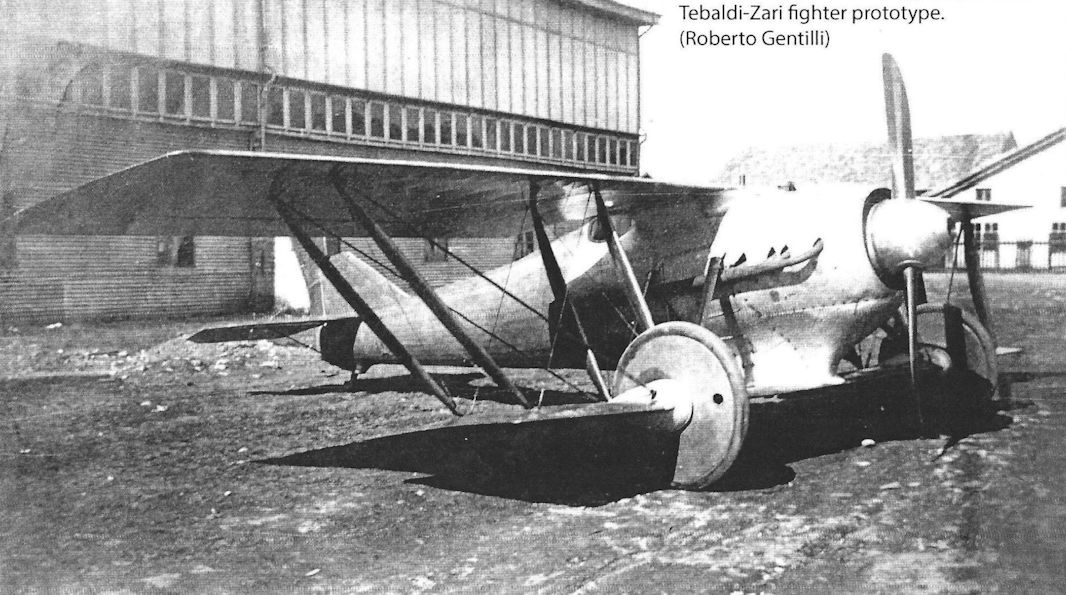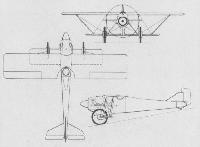W.Green, G.Swanborough The Complete Book of Fighters
TEBALDI-ZARI (BREDA) Italy
In 1919, the Zari brothers’ factory in Bovisio Mombello, Milan, completed the prototype of a single-seat fighter sesquiplane to the designs of one Ing Tebaldi. Of wooden construction and of unequal-span, heavily-staggered sesquiplane configuration, it was powered by a 190 hp Isotta-Fraschini V6 six-cylinder water-cooled engine and was unusual in that it had oversize mainwheels on an undercarriage of exceptionally wide track, the axle for which was incorporated in the lower wing. The design rights and prototype were purchased by Breda, and, re-engined with a 300 hp Hispano-Suiza HS 42 eight-cylinder water-cooled power plant, the Tebaldi fighter became the subject in 1922 of a draft agreement between Breda and the Commissariato d’Aeronautica for three aircraft. No contract followed, but the original prototype was modified for participation in the 1923 fighter contest of the newly-created Regia Aeronautica. Carrying an armament of two 7,7-mm guns, the Tebaldi fighter was given redesigned wings, with the upper wing of longer span and narrower chord, stagger was reduced, and the gap between the fuselage and the lower wing increased. The incline of the outer struts was also increased to attach at the undercarriage axle, so that the outer panels of the lower wing could be removed for comparative flight testing of the aircraft as a sesquiplane. Further redesign was then undertaken, the chord of the upper wing being increased, ailerons enlarged and the outer panels of the lower wing eventually being discarded permanently. The fighter did not find favour with the Regia Aeronautica and Breda abandoned further development. The following data relate to the final HS 42-powered sesquiplane configuration.
Max speed, 158 mph (255 km/h) at 6,560 ft (2 000 m).
Time to 16,405 ft (5 000 m), 16 min.
Endurance, 3.0 hrs.
Empty weight, 1,819 lb (825 kg).
Loaded weight, 2,425 lb (1100 kg).
Span, 29 ft 6 1/3 in (9,00 m).
Length, 25 ft 7 in (7,80 m).
Height, 6 ft 6 3/4 in (2,00 m).
Wing area, 236.81 sq ft (22,00 m2).
J.Davilla Italian Aviation in the First World War. Vol.3: Aircraft M-W (A Centennial Perspective on Great War Airplanes 75)
Tebaldi-Zari
The Zari brothers wood working company at Bovisio-Mombello had produced parts for the Bossi-built Curtiss Triad. It soon graduated to building completed airframes such as the FBA H, Macchi M.8, and M.F.11s. Their biggest project would have been the Pegna 8 heavy bomber, but the Regia Marina quickly put an end this project for political reasons.
In 1919, Zari decided to build its own aircraft, a singleseat fighter sesquiplane designed by ing. Tebaldi. Of wooden construction and of unequal-span, heavily staggered sesquiplane configuration, it was powered by a 190 hp Isotta-Fraschini V6 six-cylinder water cooled engine. Its most unusual feature was the wide track, oversized main wheels carried on a common axle which was incorporated into the lower wing. Control was by ailerons in the top wing. Armament would have been two synchronized Vickers machine guns.
The design rights and prototype were purchased by Breda. As a new fighter specification called for a 300-hp engine (preferably the soon to be available Hispano-Suiza HS 42 nine cylinder water-cooled power plant), the Tebaldi fighter had to be modified to carry one.
In 1922 a draft agreement between Breda and the Commissariato d’Aeronautica was signed for three aircraft. No contract followed, but the original prototype was modified for participation in the 1923 fighter contest of the newly-created Regia Aeronautica. Carrying an armament of two 7,7-mm guns, the Tebaldi fighter was given redesigned wings, with the upper wing of longer span and narrower chord, stagger was reduced, and the gap between the fuselage and the lower wing increased. The incline of the outer struts was also increased to attach at the undercarriage axle, so that the outer panels of the lower wing could be removed for comparative flight testing of the aircraft as a sesquiplane. Further redesign was then undertaken, the chord of the upper wing being increased, ailerons enlarged and the outer panels of the lower wing eventually being discarded permanently.
The Breda Tebaldi-Zari was now in competition with the Ansaldo A.201, Caproni C.64, Dornier H (built under license by SAICM), Fiat CR, Gabardini G.9, Macchi M.32 Piaggio P.2, and SIAI S.50.
The fighter did not find favour with the Regia Aeronautica and Breda abandoned further development.
The Regia Aeronautica ended up buying Dewoitine D.Is and Nieuport 29s as interim fighters pending the delivery of the Fiat CR which was felt to have come closest to fulfilling the Regia Aeronautica’s needs.
However, the Tebaldi-Zari was given one last chance when the Regia Aeronautica ordered two from Breda, plus one unflyable airframe for static testing. Unfortunately, the static airframe failed to meet the requirements of the coefficient of strength during static testing. The two flyable specimens were, therefore, cancelled ending, at last, the story of Tebaldi-Zari’s innovative fighter.
Tebaldi-Zari single-seat fighter with one 300 hp Hispano-Suiza HS 42 nine-cylinder water-cooled engine
Wingspan 9.00 m; Length 7.80 m; Height 2.00 m; Wing area 22.00 sq m
Empty weight, 825kg; loaded weight 1100 kg; payload 275 kg
Maximum speed, 255 km/h at 6, 560 ft (2000m), climb to 5,000 m in 16 min., endurance 3.0 hrs.



